Abstract
Ehrlichia chaffeensis are small, obligately intracellular, endosomal bacteria with tropism for macrophages. Persistent infection in reservoir white-tailed deer is transmitted by lone star ticks. Flu-like illness can progress to severe multisystem disease with toxic shock-like syndrome, meningitis, or ARDS. The case-fatality rate is 2.7%. Leukopenia and thrombocytopenia are diagnostically useful. Granulomas are associated with control of the infection. Ehrlichial proteins and glycoproteins have been sequenced and expressed for diagnostic serology and vaccine development. Mouse models (mild disease and persistent infection with E. muris and fatal monocytotropic ehrlichiosis with a Japanese tick isolate) revealed that CD4 and CD8 T type 1 lymphocyte responses, IFN-gamma, TNF-alpha, and antibodies play roles in protective immunity, while a weak CD4 T-helper response, overproduction of TNF-alpha, and very high IL-10 are associated with toxic shock-like mortality. Protection against fatal ehrlichiosis was achieved by prior infection with low virulence E. muris. Acute clinical diagnosis is difficult except by PCR. Response to doxycycline is dramatic.
Full text
PDF
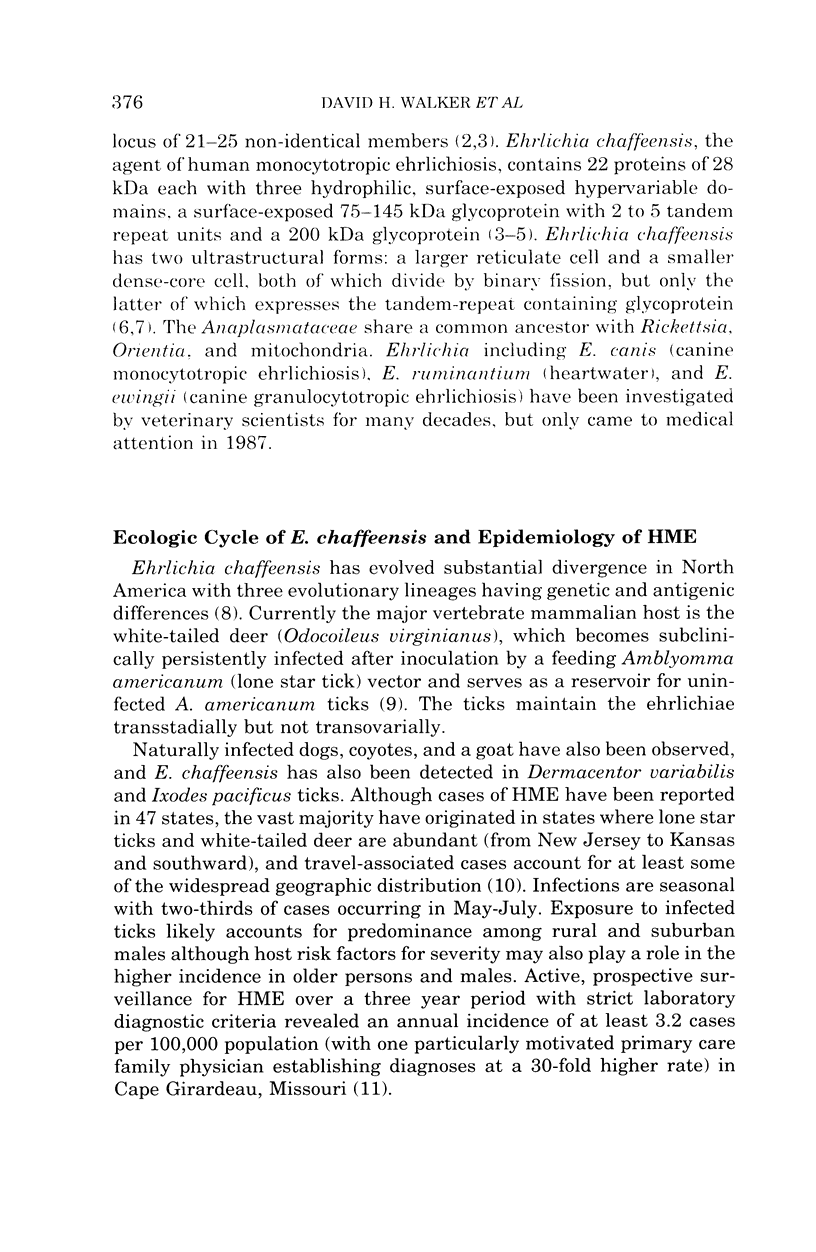

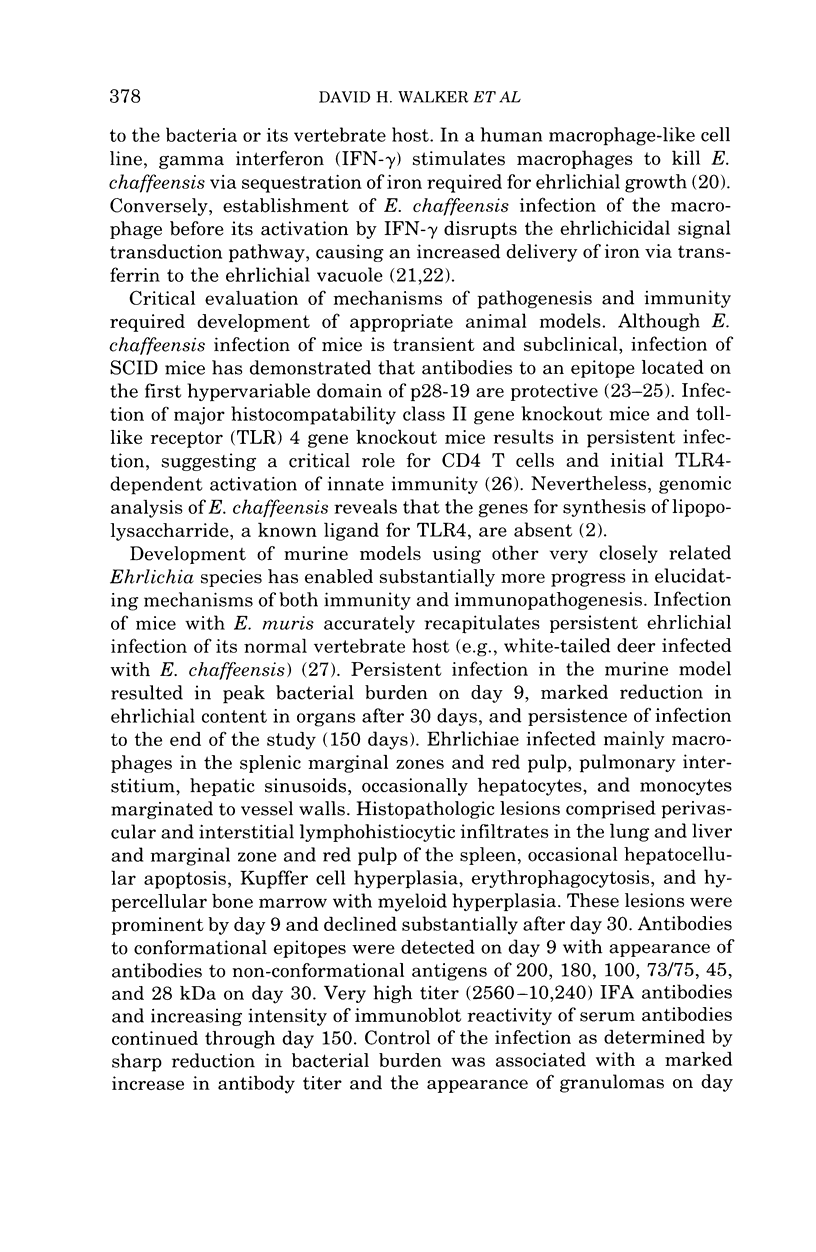

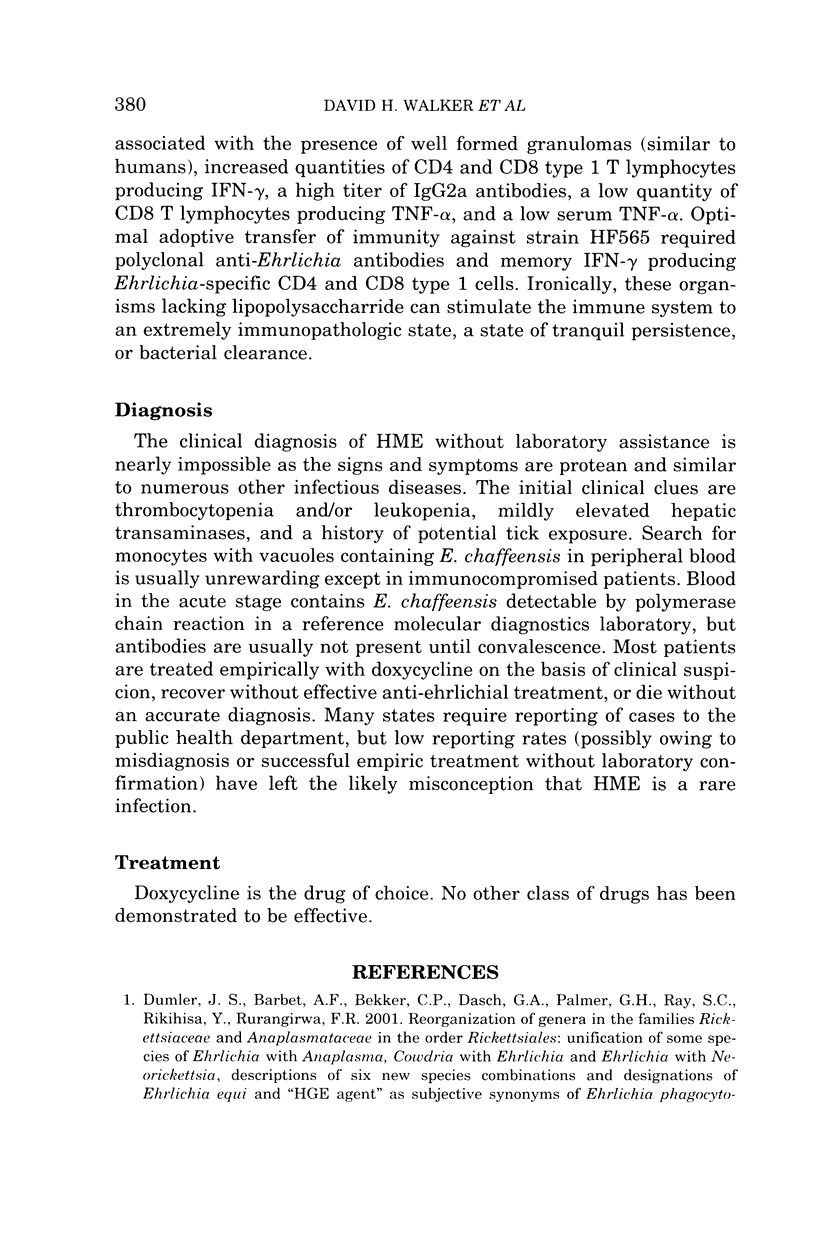
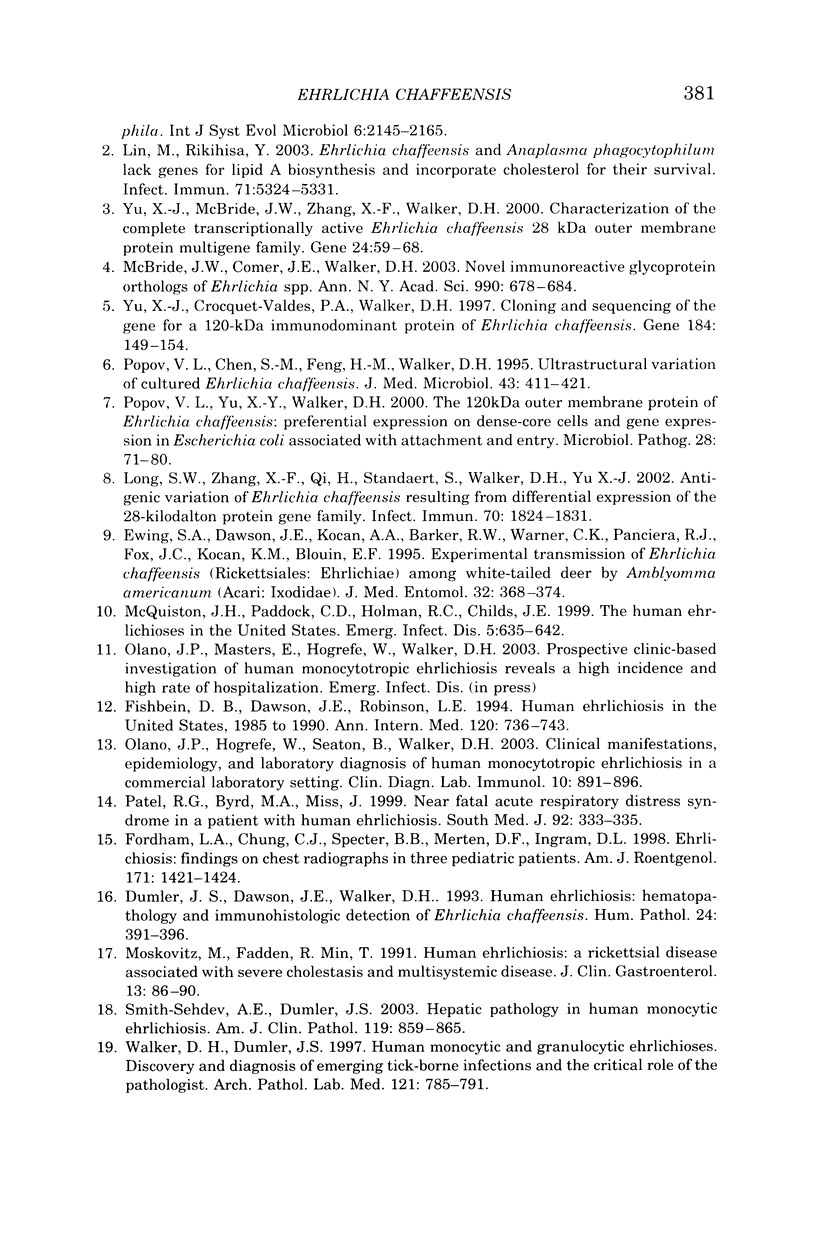
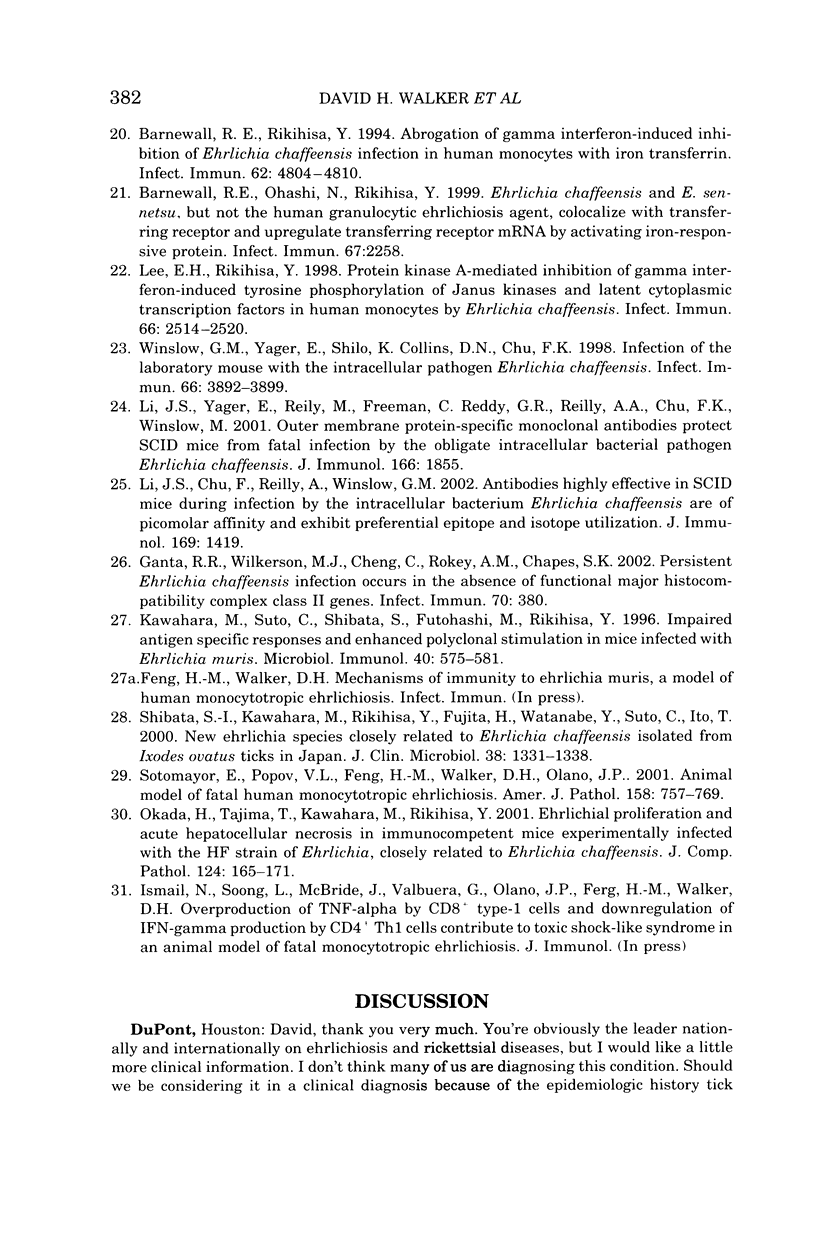
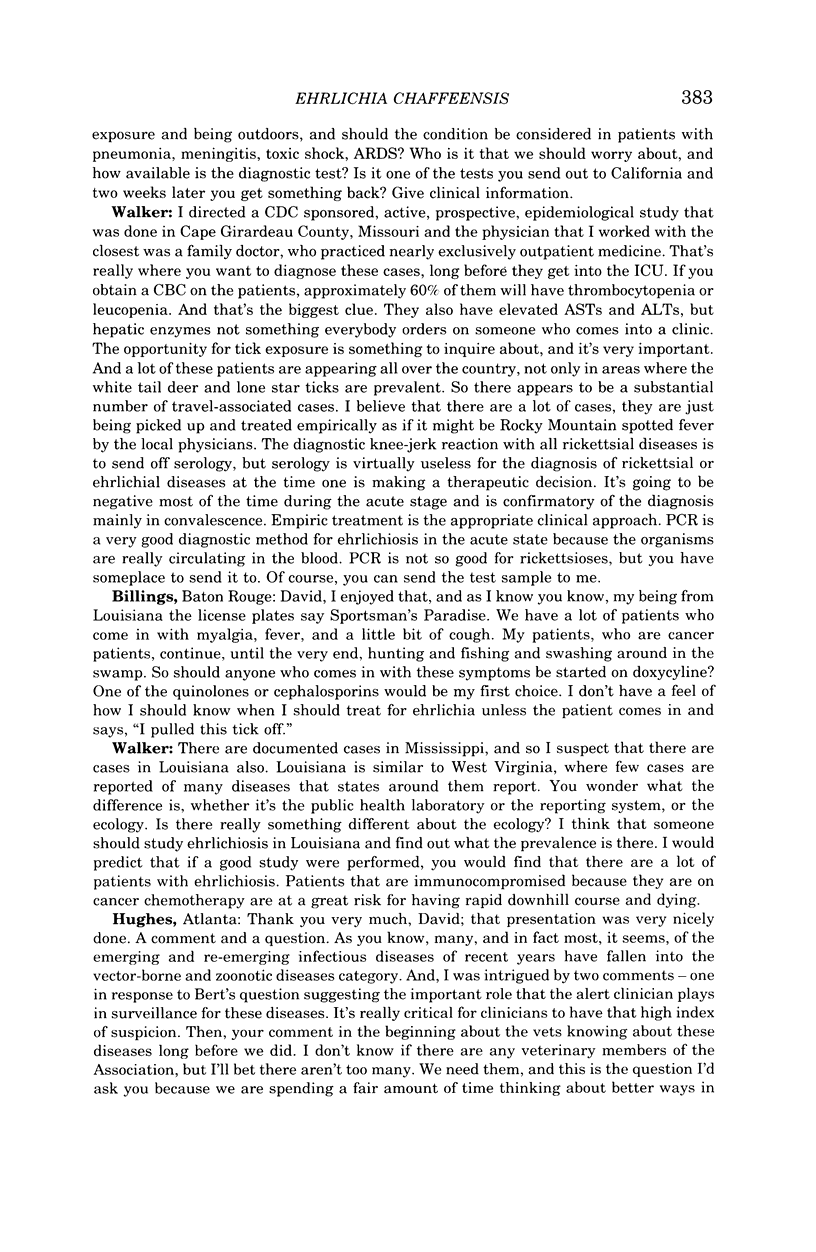

Selected References
These references are in PubMed. This may not be the complete list of references from this article.
- Barnewall R. E., Ohashi N., Rikihisa Y. Ehrlichia chaffeensis and E. sennetsu, but not the human granulocytic ehrlichiosis agent, colocalize with transferrin receptor and up-regulate transferrin receptor mRNA by activating iron-responsive protein 1. Infect Immun. 1999 May;67(5):2258–2265. doi: 10.1128/iai.67.5.2258-2265.1999. [DOI] [PMC free article] [PubMed] [Google Scholar]
- Barnewall R. E., Rikihisa Y. Abrogation of gamma interferon-induced inhibition of Ehrlichia chaffeensis infection in human monocytes with iron-transferrin. Infect Immun. 1994 Nov;62(11):4804–4810. doi: 10.1128/iai.62.11.4804-4810.1994. [DOI] [PMC free article] [PubMed] [Google Scholar]
- Dumler J. S., Dawson J. E., Walker D. H. Human ehrlichiosis: hematopathology and immunohistologic detection of Ehrlichia chaffeensis. Hum Pathol. 1993 Apr;24(4):391–396. doi: 10.1016/0046-8177(93)90087-w. [DOI] [PubMed] [Google Scholar]
- Ewing S. A., Dawson J. E., Kocan A. A., Barker R. W., Warner C. K., Panciera R. J., Fox J. C., Kocan K. M., Blouin E. F. Experimental transmission of Ehrlichia chaffeensis (Rickettsiales: Ehrlichieae) among white-tailed deer by Amblyomma americanum (Acari: Ixodidae). J Med Entomol. 1995 May;32(3):368–374. doi: 10.1093/jmedent/32.3.368. [DOI] [PubMed] [Google Scholar]
- Fishbein D. B., Dawson J. E., Robinson L. E. Human ehrlichiosis in the United States, 1985 to 1990. Ann Intern Med. 1994 May 1;120(9):736–743. doi: 10.7326/0003-4819-120-9-199405010-00003. [DOI] [PubMed] [Google Scholar]
- Fordham L. A., Chung C. J., Specter B. B., Merten D. F., Ingram D. L. Ehrlichiosis: findings on chest radiographs in three pediatric patients. AJR Am J Roentgenol. 1998 Nov;171(5):1421–1424. doi: 10.2214/ajr.171.5.9798890. [DOI] [PubMed] [Google Scholar]
- Ganta Roman Reddy, Wilkerson Melinda J., Cheng Chuanmin, Rokey Aaron M., Chapes Stephen K. Persistent Ehrlichia chaffeensis infection occurs in the absence of functional major histocompatibility complex class II genes. Infect Immun. 2002 Jan;70(1):380–388. doi: 10.1128/IAI.70.1.380-388.2002. [DOI] [PMC free article] [PubMed] [Google Scholar]
- Kawahara M., Suto C., Shibata S., Futohashi M., Rikihisa Y. Impaired antigen specific responses and enhanced polyclonal stimulation in mice infected with Ehrlichia muris. Microbiol Immunol. 1996;40(8):575–581. doi: 10.1111/j.1348-0421.1996.tb01111.x. [DOI] [PubMed] [Google Scholar]
- Lee E. H., Rikihisa Y. Protein kinase A-mediated inhibition of gamma interferon-induced tyrosine phosphorylation of Janus kinases and latent cytoplasmic transcription factors in human monocytes by Ehrlichia chaffeensis. Infect Immun. 1998 Jun;66(6):2514–2520. doi: 10.1128/iai.66.6.2514-2520.1998. [DOI] [PMC free article] [PubMed] [Google Scholar]
- Li J. S., Yager E., Reilly M., Freeman C., Reddy G. R., Reilly A. A., Chu F. K., Winslow G. M. Outer membrane protein-specific monoclonal antibodies protect SCID mice from fatal infection by the obligate intracellular bacterial pathogen Ehrlichia chaffeensis. J Immunol. 2001 Feb 1;166(3):1855–1862. doi: 10.4049/jimmunol.166.3.1855. [DOI] [PubMed] [Google Scholar]
- Li Julia Shu-Yi, Chu Frederick, Reilly Andrew, Winslow Gary M. Antibodies highly effective in SCID mice during infection by the intracellular bacterium Ehrlichia chaffeensis are of picomolar affinity and exhibit preferential epitope and isotype utilization. J Immunol. 2002 Aug 1;169(3):1419–1425. doi: 10.4049/jimmunol.169.3.1419. [DOI] [PubMed] [Google Scholar]
- Lin Mingqun, Rikihisa Yasuko. Ehrlichia chaffeensis and Anaplasma phagocytophilum lack genes for lipid A biosynthesis and incorporate cholesterol for their survival. Infect Immun. 2003 Sep;71(9):5324–5331. doi: 10.1128/IAI.71.9.5324-5331.2003. [DOI] [PMC free article] [PubMed] [Google Scholar]
- Long S. Wesley, Zhang Xiao-Feng, Qi Hai, Standaert Steven, Walker David H., Yu Xue-Jie. Antigenic variation of Ehrlichia chaffeensis resulting from differential expression of the 28-kilodalton protein gene family. Infect Immun. 2002 Apr;70(4):1824–1831. doi: 10.1128/IAI.70.4.1824-1831.2002. [DOI] [PMC free article] [PubMed] [Google Scholar]
- McBride Jere W., Comer Jason E., Walker David H. Novel Immunoreactive glycoprotein orthologs of Ehrlichia spp. Ann N Y Acad Sci. 2003 Jun;990:678–684. doi: 10.1111/j.1749-6632.2003.tb07443.x. [DOI] [PubMed] [Google Scholar]
- McQuiston J. H., Paddock C. D., Holman R. C., Childs J. E. The human ehrlichioses in the United States. Emerg Infect Dis. 1999 Sep-Oct;5(5):635–642. doi: 10.3201/eid0505.990504. [DOI] [PMC free article] [PubMed] [Google Scholar]
- Moskovitz M., Fadden R., Min T. Human ehrlichiosis: a rickettsial disease associated with severe cholestasis and multisystemic disease. J Clin Gastroenterol. 1991 Feb;13(1):86–90. [PubMed] [Google Scholar]
- Okada H., Tajima T., Kawahara M., Rikihisa Y. Ehrlichial proliferation and acute hepatocellular necrosis in immunocompetent mice experimentally infected with the HF strain of Ehrlichia, closely related to Ehrlichia chaffeensis. J Comp Pathol. 2001 Feb-Apr;124(2-3):165–171. doi: 10.1053/jcpa.2000.0447. [DOI] [PubMed] [Google Scholar]
- Olano Juan P., Hogrefe Wayne, Seaton Brent, Walker David H. Clinical manifestations, epidemiology, and laboratory diagnosis of human monocytotropic ehrlichiosis in a commercial laboratory setting. Clin Diagn Lab Immunol. 2003 Sep;10(5):891–896. doi: 10.1128/CDLI.10.5.891-896.2003. [DOI] [PMC free article] [PubMed] [Google Scholar]
- Patel R. G., Byrd M. A. Near fatal acute respiratory distress syndrome in a patient with human ehrlichiosis. South Med J. 1999 Mar;92(3):333–335. doi: 10.1097/00007611-199903000-00017. [DOI] [PubMed] [Google Scholar]
- Popov V. L., Chen S. M., Feng H. M., Walker D. H. Ultrastructural variation of cultured Ehrlichia chaffeensis. J Med Microbiol. 1995 Dec;43(6):411–421. doi: 10.1099/00222615-43-6-411. [DOI] [PubMed] [Google Scholar]
- Popov V. L., Yu X. j., Walker D. H. The 120 kDa outer membrane protein of Ehrlichia chaffeensis: preferential expression on dense-core cells and gene expression in Escherichia coli associated with attachment and entry. Microb Pathog. 2000 Feb;28(2):71–80. doi: 10.1006/mpat.1999.0327. [DOI] [PubMed] [Google Scholar]
- Sehdev Ann E., Dumler J. Stephen. Hepatic pathology in human monocytic ehrlichiosis. Ehrlichia chaffeensis infection. Am J Clin Pathol. 2003 Jun;119(6):859–865. doi: 10.1309/F7EA-B5P7-3217-16LJ. [DOI] [PubMed] [Google Scholar]
- Shibata S., Kawahara M., Rikihisa Y., Fujita H., Watanabe Y., Suto C., Ito T. New Ehrlichia species closely related to Ehrlichia chaffeensis isolated from Ixodes ovatus ticks in Japan. J Clin Microbiol. 2000 Apr;38(4):1331–1338. doi: 10.1128/jcm.38.4.1331-1338.2000. [DOI] [PMC free article] [PubMed] [Google Scholar]
- Sotomayor E. A., Popov V. L., Feng H. M., Walker D. H., Olano J. P. Animal model of fatal human monocytotropic ehrlichiosis. Am J Pathol. 2001 Feb;158(2):757–769. doi: 10.1016/S0002-9440(10)64018-7. [DOI] [PMC free article] [PubMed] [Google Scholar]
- Walker D. H., Dumler J. S. Human monocytic and granulocytic ehrlichioses. Discovery and diagnosis of emerging tick-borne infections and the critical role of the pathologist. Arch Pathol Lab Med. 1997 Aug;121(8):785–791. [PubMed] [Google Scholar]
- Winslow G. M., Yager E., Shilo K., Collins D. N., Chu F. K. Infection of the laboratory mouse with the intracellular pathogen Ehrlichia chaffeensis. Infect Immun. 1998 Aug;66(8):3892–3899. doi: 10.1128/iai.66.8.3892-3899.1998. [DOI] [PMC free article] [PubMed] [Google Scholar]
- Yu X. J., Crocquet-Valdes P., Walker D. H. Cloning and sequencing of the gene for a 120-kDa immunodominant protein of Ehrlichia chaffeensis. Gene. 1997 Jan 15;184(2):149–154. doi: 10.1016/s0378-1119(96)00586-0. [DOI] [PubMed] [Google Scholar]
- Yu X., McBride J. W., Zhang X., Walker D. H. Characterization of the complete transcriptionally active ehrlichia chaffeensis 28 kDa outer membrane protein multigene family. Gene. 2000 May 2;248(1-2):59–68. doi: 10.1016/s0378-1119(00)00147-5. [DOI] [PubMed] [Google Scholar]


